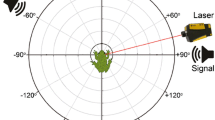Summary
-
1.
Approximately 430 wind-sensitive hairs are found on the head of Locusta.
-
2.
Hair-length-distribution can be satisfactorily divided into three classes: 1. 1<150 μm (∼76%), 2. 150≦1<230 μm (∼17%), 3. 1≧230 μm (∼7%).
-
3.
The mechanics of the hair-socket was examined in unfixed sections of the cuticle. The cutting left the sensillum uninjured. The socket wall surrounds the hair on all sides like a close-fitting sleeve. When deflected to any side, the hair engages the sleeve as a fulcrum. The membrane joining the hair with cuticle then behaves as an elastic band easily stretched. No deformation of the hair in the neighbourhood of the socket was observed.
-
4.
Elastic forces generated by deflecting the hair are constant for the same degree of deflection no matter what its direction.
-
5.
When a jet of air is directed at the head of Locusta, the extent of deflection of a hair depends upon the local air current field at the hair; that is, besides hair length and air speed, the degree of deflection depends on the angle of the air stream with the head and on the shape of the head at and near the hair.
-
6.
The effect of air speed and direction on the generation of deflection patterns of the hairs across the head and their corresponding impulse sequences is discussed along with the possible significance of the patterns for the locust.
Zusammenfassung
-
1.
Auf dem Kopf von Locusta befinden sich durchschnittlich 430 windempfindliche Haare.
-
2.
Die Längen aller Haare verteilen sich recht gut auf drei Gruppen: 1.1<150 μm (im Mittel 76%), 2. 150≦1<230 μm (17%), 3. 1≧230 μm (7%).
-
3.
Die Mechanik des Haarsockels wird an Lebendschnitten mit intaktem Sockelapparat untersucht. Der Haarschaft wird oberhalb der Gelenkmembran von einer Manschette umfaßt. Bei einer Auslenkung des Haares wird der Schaft um die als allseitigen Anschlag wirkende Manschette gekippt; die Gelenkmembran verhält sich dabei wie ein elastisches Band mit geringer Federkonstante. Eine Verformung des Schaftes im Bereich des Sockels läßt sich nicht beobachten.
-
4.
Die bei konstanten Auslenkungen des Haares auftretenden rücktreibenden Kräfte sind von der Richtung unabhängig.
-
5.
Die Auslenkung eines Haares ist vom lokalen Strömungsfeld abhängig; die Auslenkung ist sowohl von der Haarlänge und der Windgeschwindigkeit als auch von der Windrichtung und dem Standort des Haares auf dem Kopf abhängig.
-
6.
Die Ausbildung von örtlichen Auslenk- und Erregungsmustern in Abhängigkeit von der Windrichtung und -geschwindigkeit und ihre mögliche Bedeutung für die Heuschrecke werden diskutiert.
Similar content being viewed by others
Literatur
Bilo, D.: Untersuchungen über die Flugbiophysik von Kleinvögeln. Diss. a. d. Nat. Fak., Universität München, 1969.
Camhi, J.: Locust wind receptors. I. Transducer mechanics and sensory response. J. exp. Biol. 50, 335–348 (1969a).
— Locust wind receptors. II. Interneurons in the cervical connective. J. exp. Biol. 50, 349–362 (1969b).
— Locust wind receptors. III. Contribution to flight initiation and lift control. J. exp. Biol. 50, 363–373 (1969c).
Dubs, F.: Aerodynamik der reinen Unterschallströniung. Basel-Stuttgart: Birkhäuser 1954.
Guthrie, D. M.: Observations on the nervous system of the flight apparatus in the locust Schistocerca gregaria. Quart. J. micr. Sci. 105 (2), 183–201 (1964).
—: The function and fine structure of the cephalic airflow receptor in Schistocerca gregaria. J. Cell Sci. 1, 463–470 (1966).
Haskell, P. T.: Physiology of some wind-sensitive receptors of the desert locust (S. gregaria). Proc. 15th Int. Congr. Zool. (London 1958), 960–961 (1959).
—: The sensory equipment of the migratory locust. Symp. zool. Soc. London 3, 1–23 (1960).
Mallory, F. B.: In: Romeis, B., Mikroskopische Technik, S. 363–370. München-Wien: R. Oldenbourg 1968.
Nicklaus, R.: Die Erregung einzelner Fadenhaare von Periplaneta americana in Abhängigkeit von der Größe und Richtung der Auslenkung. Z. vergl. Physiol. 50, 331–362 (1965).
Smola, U.: Übertragungseigenschaften von Mechanorezeptoren bei Insekten. Morphologie, Mechanik und Elektrophysiologie der windempfindlichen Rezeptoren auf dem Kopf der Wanderheuschrecke Locusta migratoria. Diss. a. d. Nat. Fak., Universität München, 1969.
Sviderskii, V.: Electrical activity in receptors concerned with maintainance of flight in locusts. Dokl. Akad. Nauk SSSR 172 (5), 1230–1233 (1967) [Russisch].
—: Central transformation of impulses sent by the head receptors to the neurons of wing muscles in the locust. Dokl. Akad. Nauk SSSR 183, 486–489 (1968) [Russisch].
Thurm, U.: Die Beziehung zwischen mechanischen Reizgrößen und stationären Erregungszuständen bei Borstenfeld-Sensillen von Bienen. Z. vergl. Physiol. 46, 351–382 (1963).
Weis-Fogh, T.: An aerodynamic sense organ stimulating and regulating flight in locusts. Nature (Lond.) 164, 873–874 (1949).
- An aerodynamic sense organ in locusts. 8th Congr. intern. Entomol. 1948, 584–588 (1950).
—: Biology and physics of locust flight. II. Flight performance of the desert locust (Schistocerca greg.). Phil. Trans. B 239, 459–510 (1956a).
—: Biology and physics of locust flight. IV. Notes on sensory mechanisms in locust flight. Phil. Trans. B 239, 553–584 (1956b).
Author information
Authors and Affiliations
Additional information
Herrn Prof. Dr. Dr. h. c. H. Autrum danke ich sehr für die Förderung dieser Arbeit. Die Versuche wurden zum Teil mit Geräten ausgeführt, die die Deutsche Forschungsgemeinschaft Herrn Prof. Autrum zur Verfügung stellte.
Rights and permissions
About this article
Cite this article
Smola, U. Untersuchung zur Topographie, Mechanik und Strömungsmechanik der Sinneshaare auf dem Kopf der Wanderheuschrecke Locusta migratoria . Z. Vergl. Physiol. 67, 382–402 (1970). https://doi.org/10.1007/BF00297907
Received:
Issue Date:
DOI: https://doi.org/10.1007/BF00297907




